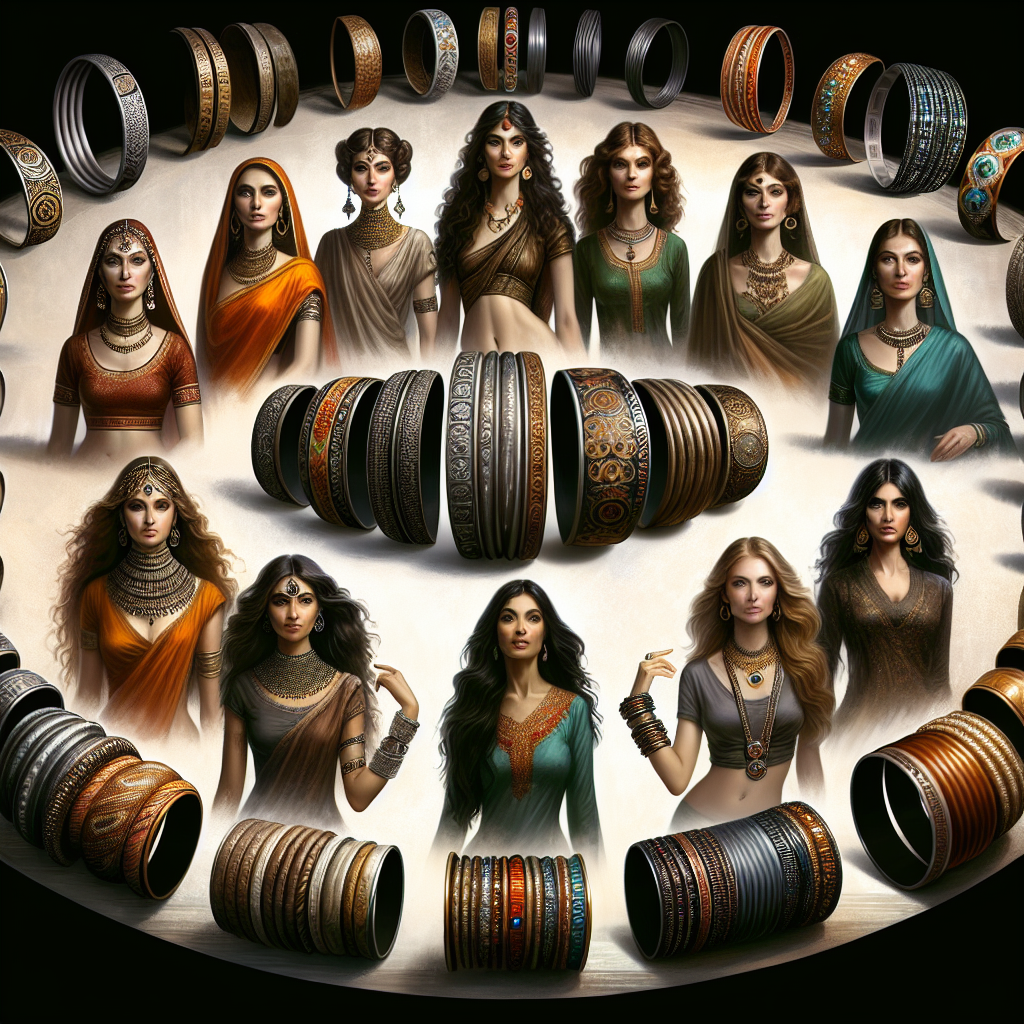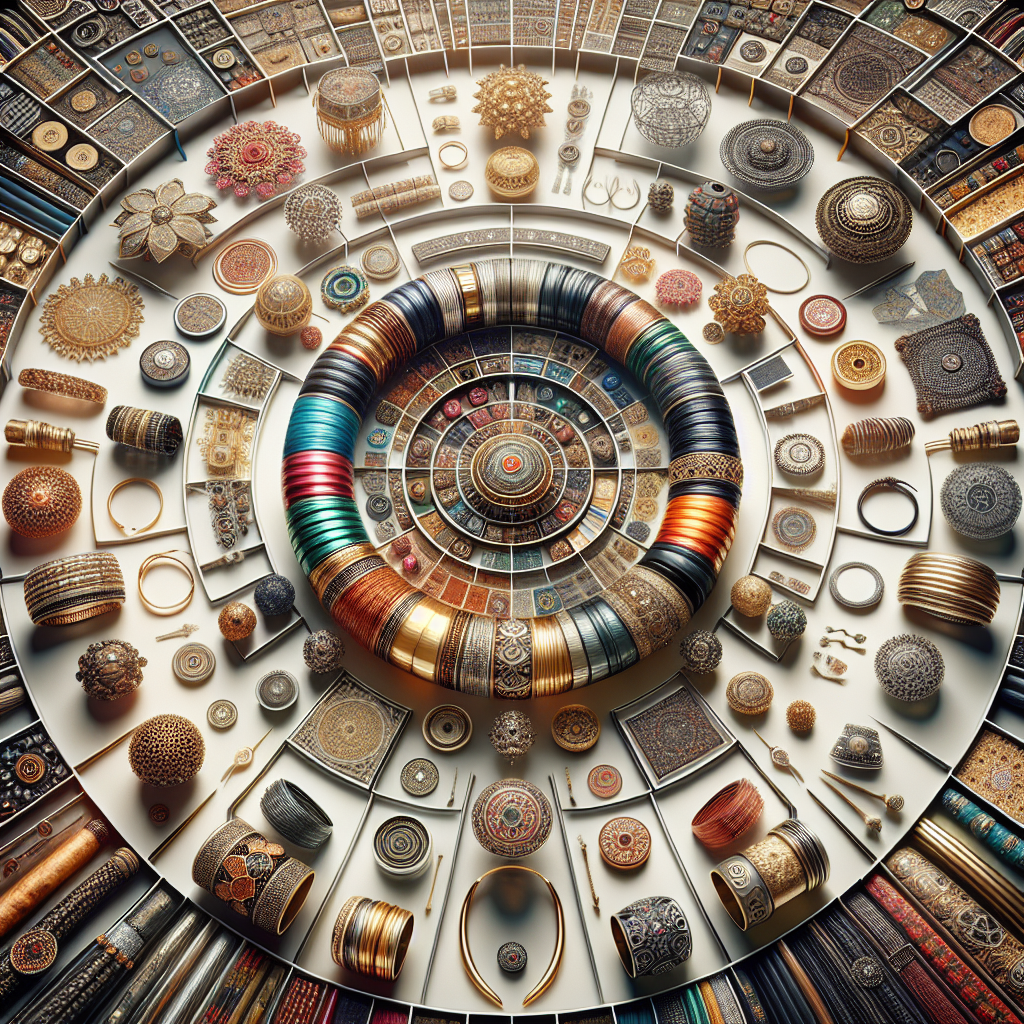Have you ever wondered why those beautiful, jingling bracelets adorning wrists all around the world are called “bangles”? Curiosity might prompt you to delve into the origins of this fascinating name. As we explore the etymology behind this beloved accessory, we’ll uncover the cultural significance, historical connections, and the enchanting allure that bangles bring to our lives. Let’s embark on a captivating journey to unravel the mystery of why they are called bangles.
Benevolence LA Plush Velvet Jewelry Box | Travel Jewelry Case Organizer with Mirror | Featured in Oprah's Favorite Things | Best Gifts For Daughter, Girlfriend, Mom | Gifts For Her - Dusty Pink
$15.74 (as of November 28, 2025 16:28 GMT +00:00 - More infoProduct prices and availability are accurate as of the date/time indicated and are subject to change. Any price and availability information displayed on [relevant Amazon Site(s), as applicable] at the time of purchase will apply to the purchase of this product.)Rotating Jewelry Box Large Capacity with Mirror, 4-Layer Rotating Jewelry Storage Box for Bracelets Rings Earrings, Gift for Women, Blue
$0.96 (as of November 28, 2025 16:28 GMT +00:00 - More infoProduct prices and availability are accurate as of the date/time indicated and are subject to change. Any price and availability information displayed on [relevant Amazon Site(s), as applicable] at the time of purchase will apply to the purchase of this product.)HOME SMILE Ceramic Ring Dish Jewelry Tray for Mom Sister Friends
$7.99 (as of November 28, 2025 16:28 GMT +00:00 - More infoProduct prices and availability are accurate as of the date/time indicated and are subject to change. Any price and availability information displayed on [relevant Amazon Site(s), as applicable] at the time of purchase will apply to the purchase of this product.)Corissy Personalized Jewelry Box for Women, Custom Travel Jewelry Case with Name and Birth Flower, Leather Jewelry Box for Rings, Earrings, Necklaces, Personalized Gifts for Women
$6.99 (as of November 28, 2025 16:28 GMT +00:00 - More infoProduct prices and availability are accurate as of the date/time indicated and are subject to change. Any price and availability information displayed on [relevant Amazon Site(s), as applicable] at the time of purchase will apply to the purchase of this product.)BAGSMART Travel Jewelry Organizer Case Foldable Small Jewelry Roll for Journey Rings, Necklaces, Earrings, Bracelets,Mini,Soft Pink
$11.87 (as of November 28, 2025 16:28 GMT +00:00 - More infoProduct prices and availability are accurate as of the date/time indicated and are subject to change. Any price and availability information displayed on [relevant Amazon Site(s), as applicable] at the time of purchase will apply to the purchase of this product.)
Etymology of the Word
Bangles, those beautiful bracelets that adorn your wrists, have a fascinating etymology that traces back to various cultures and languages. While the exact origin of the word “bangle” is not entirely clear, there are a few possible origins that could shed some light on its meaning and history.
Possible Origins
One theory suggests that the word “bangle” may have derived from the Hindi word “bangri” or “bangadi,” which refers to a traditional Indian bracelet often made of glass or metal. Another possible origin is the Persian word “bangala,” which means “glass bracelet.” These words eventually made their way into the English language, and “bangle” became the commonly used term to describe these decorative wrist adornments.
Different Names in Different Cultures
What’s fascinating about bangles is that they are not solely associated with one specific culture. In fact, different cultures around the world have their own names for these wrist ornaments. In India, for example, they are called “chudi” or “kangan,” whereas in the Middle East, they are referred to as “hajek,” “jar,” or “midra.” African cultures also have their own names for bangles, such as “niral” in Nigeria and “jingle” or “morsa” in Ghana. These diverse names reflect the cultural significance and long history of bangles across various societies.
Historical Significance
Bangles have a rich historical significance that dates back centuries. They have been worn by men and women alike and hold immense symbolic importance in different cultures.
Ancient Origins
The use of bangles can be traced back thousands of years to ancient civilizations such as Mesopotamia, Egypt, and the Indus Valley. Archaeological excavations have unearthed bangles made from a variety of materials, including shells, precious stones, metals, and even bones. These artifacts suggest that bangles were not only ornamental but also held ritualistic and spiritual significance.
Symbolic Importance
In many cultures, bangles have symbolized various attributes and beliefs. In Indian culture, bangles are often associated with marriage and fertility, and newlywed brides wear a set of bangles called “chooda” as a symbol of their marital status. In Middle Eastern culture, bangles represent beauty, femininity, and wealth. They are often worn during special occasions and celebrations. Bangles have also been used historically as protective talismans, symbols of social status, and markers of cultural identity.

Types of Bangles
Bangles come in an array of designs and are crafted from a variety of materials. The types of bangles reflect the cultural diversity and craftsmanship of different regions.
Materials Used
Traditionally, bangles were made from natural materials like wood, bone, shells, and clay. However, as civilizations advanced, bangles started to be crafted from more refined materials such as gold, silver, glass, and precious stones. Today, bangles are still made from a wide range of materials, including metals like brass and copper, as well as synthetic materials like plastic and acrylic.
Traditional Designs
The designs of bangles vary greatly, each reflecting the cultural identity and artistic traditions of its origin. Indian bangles, for example, often feature intricate patterns, engravings, and embellishments with beads, mirrors, or precious stones. Middle Eastern bangles, on the other hand, often showcase delicate filigree work, geometric patterns, and vibrant enamel detailing. African bangles are characterized by their bold and vibrant colors, often made from natural materials like clay or cowrie shells.
Bangles in Different Cultures
Bangles have played a significant role in various cultures, and their symbolism and usage may vary from one culture to another.
Indian Culture
In Indian culture, bangles hold deep cultural and religious significance. They are considered an essential part of traditional attire and are worn by women of all ages. Indian brides often wear a set of bridal bangles, known as “chooda,” which are usually red and white in color and signify marriage and good fortune. Different regions within India have their own unique styles of bangles, such as the lac bangles of Rajasthan and the gold bangles of South India.
Middle Eastern Culture
In Middle Eastern culture, bangles are highly valued for their beauty and craftsmanship. They are an integral part of traditional attire and are often worn during weddings, religious festivals, and special occasions. Middle Eastern bangles come in various styles, including those adorned with gemstones, intricate metalwork, or enamel detailing. They are considered symbols of femininity and elegance.
African Culture
In many African cultures, bangles hold cultural significance and are deeply intertwined with traditional practices and beliefs. They are often worn as part of cultural attire during ceremonies, dances, and rituals. African bangles are known for their vibrant colors, use of natural materials like shells and beads, and their role in enhancing bodily movements during dance performances.

Bangles as Fashion Accessories
Over the years, bangles have gained immense popularity as fashion accessories, transcending cultural boundaries and becoming a staple in the fashion industry.
Popularity in Fashion Industry
Bangles have made their way onto catwalks and into fashion magazines, captivating designers and fashion enthusiasts alike. Their versatility and ability to complement various outfits make them a popular choice for fashion-conscious individuals. From high-end designer collections to street fashion, bangles have become a must-have accessory for those looking to add a touch of elegance and cultural flair to their style.
Various Ways to Wear Bangles
Part of the appeal of bangles is the multitude of ways they can be worn. Whether stacked on one arm or worn individually, bangles offer endless possibilities for creating unique and personalized looks. They can be layered with other bracelets, paired with a watch, or mixed and matched to create a bohemian-inspired stack. The variety of colors, materials, and designs make it easy to find the perfect bangles to suit your personal style and elevate any outfit.
Bangle Traditions and Customs
Bangles hold significant cultural and religious importance in various traditions and customs around the world.
Wedding Bangles
One of the most prominent traditions involving bangles is their use in weddings. In many cultures, the bride wears a specific set of bangles as a symbol of her married status. These wedding bangles often have symbolic colors and designs, representing fertility, prosperity, and marital bliss. In some traditions, the bride’s mother or close relatives gift the bridal bangles, passing on family traditions and blessings to the newlywed couple.
Religious Significance
In addition to weddings, bangles also hold religious significance in many cultures. In Hinduism, for example, bangles are considered auspicious and are often worn during religious ceremonies and festivals. They are believed to bring good luck and protect against evil spirits. In Sikhism, bangles known as “kara” are one of the five articles of faith worn by followers as symbols of their religious identity and commitment.

Evolution of Bangles
Like any fashion accessory, the design of bangles has evolved over time to reflect changing trends and influences from other cultures.
Modern Designs
Contemporary bangle designs often incorporate modern elements while retaining traditional craftsmanship. From minimalist and sleek designs to bold and statement-making pieces, modern bangles cater to a wide range of aesthetics and preferences. Metals like stainless steel and titanium are frequently used, giving bangles a contemporary edge. In addition, innovative materials, such as recycled and sustainable materials, are becoming increasingly popular in the creation of eco-friendly bangles.
Influence of Western Fashion
The influence of Western fashion has also played a role in the evolution of bangle designs. Globalization and cultural exchange have led to a fusion of traditional and contemporary styles, creating unique and fashionable pieces that appeal to a broader audience. This cross-cultural influence can be seen in the incorporation of Western motifs, like geometric patterns or modern materials, into traditional bangle designs, resulting in a vibrant and diverse range of options for fashion enthusiasts around the world.
Bangles as Symbols of Femininity
Throughout history, bangles have been associated with femininity and have played a role in shaping perceptions of womanhood.
Historical Perception
In many cultures, bangles have been viewed as symbols of femininity and beauty. The delicate sound they produce when worn adds to their allure, and the way they adorn a woman’s wrists has often been associated with grace and elegance. Bangles have been considered an essential accessory for married women, signifying their marital status and traditional roles.
Role in Empowerment Movements
In recent years, bangles have taken on new meanings and have become symbols of empowerment for women. They are worn as a celebration of womanhood, confidence, and strength. Bangles have become a visual representation of the resilience and determination of women, serving as a reminder to embrace one’s femininity and empower others in the process. By embracing bangles, women are reclaiming their history and cultural heritage, while also making a bold fashion statement.

Bangles in Literature and Art
The beauty and symbolism of bangles have often inspired artists and writers to incorporate them into their works, both as visual motifs and metaphorical symbols.
Depictions in Poetry and Paintings
Throughout history, bangles have featured prominently in poetry and paintings, capturing their aesthetic appeal and cultural significance. Poets have praised the jingling sound and elegance of bangles, using them as metaphors for love, femininity, and the passage of time. Painters have immortalized the beauty of bangles through detailed portraits, showcasing their intricate designs and the emotions they evoke.
Symbolism in Storytelling
Bangles have also been utilized as powerful symbols in storytelling. They can represent cultural identity, social status, or signify life milestones. In literature, bangles have been used as narrative devices to explore themes of tradition, femininity, and societal expectations. By weaving bangles into their stories, authors create a deeper connection between their characters and readers, allowing for a broader exploration of themes and emotions.
Controversies Surrounding Bangles
While bangles are beloved by many, they are not without their controversies and ethical concerns.
Cultural Appropriation
One of the main controversies surrounding bangles and other cultural accessories is the issue of cultural appropriation. When individuals from non-cultural backgrounds wear bangles as a fashion statement without understanding their cultural significance, it can be seen as disrespectful and insensitive. It is important to recognize and respect the cultural origins and symbolism of bangles when incorporating them into personal style choices.
Ethical Concerns
Another concern lies in the ethical implications of the materials used to make bangles. The use of unsustainable or environmentally harmful materials, as well as unethical labor practices in the manufacturing process, can detract from the beauty and cultural significance of bangles. It is essential for consumers to prioritize ethical and sustainable options when choosing bangles, supporting artisans and brands that prioritize fair trade practices and environmentally friendly materials.
In conclusion, bangles are more than just decorative wrist adornments. They carry a rich history, cultural significance, and timeless beauty that transcends borders and connects diverse communities. From their ancient origins to their modern interpretations, bangles have evolved while still retaining their symbolic power. Whether worn as a fashion statement or a celebration of cultural identity, bangles continue to adorn wrists with elegance, grace, and a sense of empowerment.






